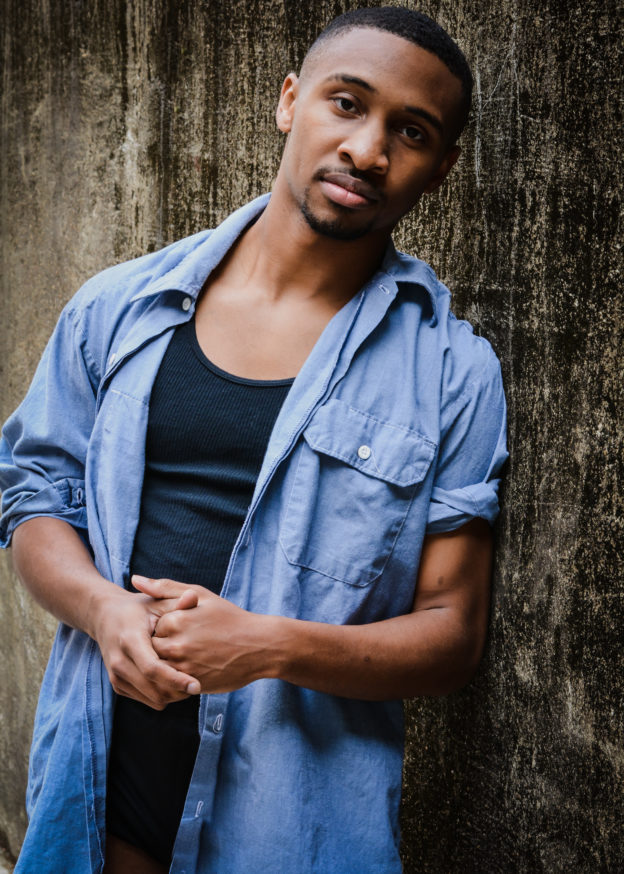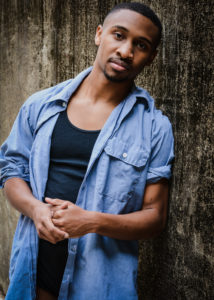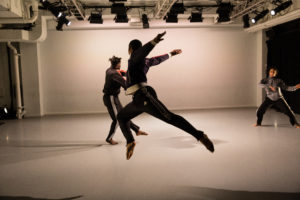

Editor’s Note: Recently, the National Center for Choreography in Akron, Ohio started a low-residency dance writing laboratory. The lab currently houses a cohort of five writers from around the country, including Bay Area-based Sima Belmar, who contributes regularly to In Dance with her “In Practice” column. Dancers’ Group reached out to this group to seek fresh voices and perspectives on dance – coming from across the US – which we can bring back to our community. The following piece emerges from that outreach: Benedict Nguyen in a conversation with New York artist Johnnie Cruise Mercer about social justice, radicalism, commodification in dance, and more.
After a preview performance of New York-based The Red Project NYC’s recent work, Sanctuary, Artistic Director Johnnie Cruise Mercer facilitated an open and rigorous dialogue with the audience. He openly addressed difficult questions he was grappling with just a week before the premiere about the piece’s composition, music, casting, thematics, and more.
In our chat, Johnnie’s melting gelato similarly dripped over its cup as our conversation spilled over the distinctions between radicalism and anarchy, the tacit (and overreaching) expectations of black artists, and the self-reflection central to creating community and performance.
Aware of how I risked repeating these same expectations in the performance of this interview, I hoped to offer space for Johnnie to shift the conversation beyond what it means to be a (radical) black artist to the field at large.
He introduced his company as a group of artistic anarchists.
What follows is his elaboration and excerpts from our conversation:
Benedict Nguyen: What does artistic anarchy mean to you?
Johnnie Cruise Mercer: The way my art is being made seems constrained by the stage structure that history has developed for artists of color. So I think that artistic anarchy is completely saying “No” to how we’re brought up – Let’s build again and let’s destroy this and actually create this thing from scratch. So there’s a bit of healing in the anarchy. I feel like a lot of things – even the idea of radicalism – has come to a certain place of comfort. So I’m interested in questioning all of it.
BN: What are you questioning in your work?
JCM: I think I’m responding to expectation. I’m a black artist so there’s a certain way I should be radicalizing my practice or doing certain things. I’m responding to capitalism; I’m responding to the molds that came before me. And then I’m questioning my part in it, and then questioning the expectation for me to question in a certain way. I feel an expectation to share a certain way, to share a certain type of thing, to present it in a way that is acceptable to certain people. Without the expectation of the community giving to you. There’s a mold, almost like a non-freedom to ‘Black Radicalism.’
BN: If an artist is read as a radical black artist, what would the people who are reading that, who are casting that gaze upon them, expect out of that work?
JCM: They’re expecting them to be black. They’re expecting a certain amount of off-puttingness, or a certain amount of feeling, or a certain amount of disruption, and also a certain amount of selling of your blackness. When people are like, “Oh, you’re a black radicalist. Oh you’re making work that’s black. You’re selling the blackness.” And it’s performing. If you’re performing your radicalness, you’re not being radical at all, you’re just doing radical stuff to get the next gain professionally. Especially in the United States, most of the things we dwell on as performance artists are based on minstrel systems and coonery.
Now, everyone’s not like that. There are black radicalists, who really say, ‘No. I’m gonna stand up for this. This is what I’m doing.’
BN: Care to give a shout out?
JCM: Yeah, Brother(hood) Dance! Monstah Black and Hyperbolic! They are disobeying the rules of the stage and in some ways, even using the rules of the stage to make fun of the fact that they’re on stage.
I think that’s the interesting thing when you’re talking about composition of the body, composition of the society, that you’re no longer composing just the dance work that is acceptable for the space. You’re now commenting on the actual space itself by rebelling against it. When I think about myself and how I go into work, I ask, “Why even do anything in that space in general when the expectation when someone walks in is to watch you give to them and them not necessarily outwardly give to you?” I mean, if you are in a stage space how do you destroy the stage space to the point where it doesn’t even look like a stage? Just a space that you’re inhabiting and that you can engage us as artists in?
BN: Earlier, you mentioned how professional matters more than the art itself?
JCM: Right now, because of capitalist structures and the way that everything is made, you’re constantly put against what you need to do professionally to make work for your personal life and your financial life and what your art is. As a professional black artist, it is easier to label myself as a certain thing instead of actually exploring what it means to me personally. Which doesn’t make any sense to me because in my eyes, blackness can’t even be contained by the word radicalism. A human can’t be contained by anything, any word that you can actually use in the dictionary.
The idea of what your profession is collides with your art when these labels happen and you feel like you have to reach a certain thing all the time and so then your work becomes this level-gaining thing – so I’m gonna make my dance like this. And then this is the way it’s going to get to this point. But when you’re making a dance, it’s coming from something subconscious, which you can’t actually leverage. You can’t create levels. You can’t create steps to get to a certain place. You can process it, you can figure it out as you go, but unless you can live in the future, it’s impossible in art to go, “This is next, this is next, this is next” unless you’ve already done it. Your art has to be gauged not by your career but your purpose.

BN: There’s been a resurging in interest in social justice or anti-oppressive frameworks in making art.
JCM: Humans are interesting. We react, but we don’t always question. Even though all that stuff has been happening for hundreds of years, it’s almost like periods of peace where we decide to sit back as people and not have to do too much cause everything is okay. ‘We gon be alright.’ Why would you wait until it’s just horrible, you know what I mean? So now it’s popular to do, you know, “the work.” But “the work” should have been done. The work should have been being done and it should have continued to be done. The work can be done in art. Now “radical black art” is used as a label to make the audience aware that they’re gonna go see something that’s gonna like, shake them.
BN: An expectation for affective labor, emotional labor?
JCM: Exactly.
BN: In a twisted way.
JCM: And I don’t think it’s a compliment. Like they almost label me immediately as someone who’s gonna go against. When actually the whole point of me going in there to be radicalizing anything is to bring people in and create that give and take. But if the presenter creates this thing where I’m a black radicalist, you’re saying, “I’m gonna enter in a space and I’m gonna be radical.” Which I already know is term to say, “You’re gonna be discomforted when you see this show. And they’re gonna be of color. You know what I mean?”
BN: You’re gonna be shaken up, you’re gonna become woke after?
JCM: Right, and ‘become woke’? I don’t know why anarchy feels like it has more substance than the word radical. Anarchy has a balance to it. There’s a purposeful action of removal of something that’s already happened. And saying, “I’m gonna build to something else.”
BN: And it’s… It’s a different kind of resistance?
BN: How does this translate into interactions with funders and presenters, grant applications, and all that?
JCM: I’m interested in creating a community where there is give and take; where you’re not gonna come in and expect this or expect that, but come in and you’re here and see what happens. What is the conversation? What happens when there’s a response?
It’s kinda hard when you’re trying to figure that out with presenters and funders and explain “Hey, I’m using my blackness as a catapult to make work but it’s not something I’m willing to sell.” Which people are like, “What do you mean? You’re gonna make this piece and it’s gonna be gay and black.” And I’m like, “It’s just gonna be whatever the fuck I want it to be.”
I think people get this idea on presenters and funders like they’re bad people when they’re people. And I think that what we as artists need to go back to challenging them as people. And them not presenting you because the work you shared with them was so amazing. It was like, “You sold this to me. I’m ready to bring you in.” It’s more like, “Who are you?” Like actually having some kind of relationship. Which is hard. But it’s like, “Why wouldn’t we? We’re human.”
If you wanna actually communicate, communicate. And your dance is a dance. And your art is an art. But you’re still a person and your art doesn’t speak all of you.
BN: What might that give and take look like?
JCM: Let’s say I’m in a club and I’m like “Oh, I’m gonna go dance.” You going and trying to perform your dance doesn’t necessarily give anything to the space. And people can see you. They’re like, “What are you doing?” Especially in a black club. But if you are dancing with and dancing to the music, and you’re with everyone else, and everyone’s enjoying themselves, you’re giving to the energy of the space and it becomes this never-ending circle of give and take. And it becomes communal. And I think that the work has to be like that as well. It’s not just about the performance, it’s about, “What are you giving into the space? What are you taking from the space? And how do we engage that continuously as a cycle?”
This article appears in the December 2017 issue of In Dance.


